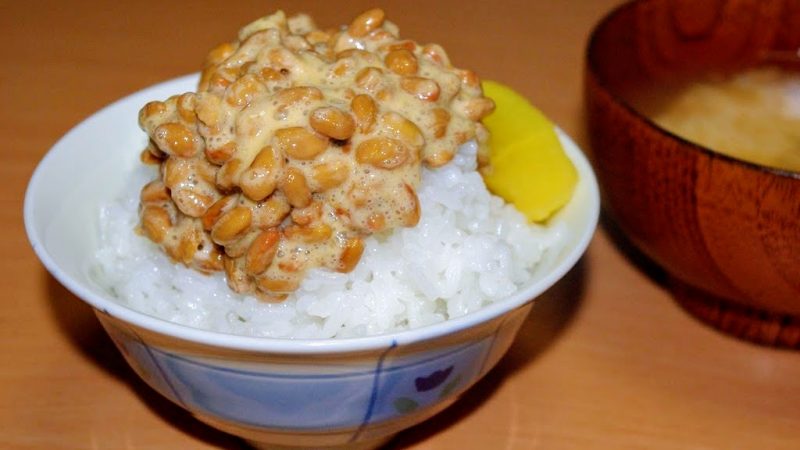Japanese superfood can't combat COVID-19, but may prolong your life

“納豆ごはん” (Natto over rice) by Flickr user Masafumi Iwai, CC BY-NC 2.0
Check out Global Voices’ special coverage of the global impact of COVID-19.
Amidst the ongoing COVID-19 pandemic, a beloved Japanese food has become even more popular. Like toilet paper, hand sanitizer and medical masks, natto, a sticky, stringy and some say even smelly fermented dish made from soybeans that is believed to boost the immune system has disappeared from supermarket shelves in Japan in March and April. Luckily, however, it's possible for anyone to make natto at home.
Natto, sometimes compared with cheese, is a traditional Japanese dish made by fermenting soybeans with a bacillus subtilis culture, or nattokin. Loved for its rich umami flavor, natto is a popular and inexpensive daily staple in many parts of Japan, and is eaten on over rice or toast, in sushi rolls, in spaghetti, or by itself, mixed with hot karashi mustard and citrus ponzu sauce.
In mid-March, Nexer, a consumer research company in Japan, found that nearly 40 percent of Japanese people they surveyed incorporated special foods into their diet in order to “boost their immune systems” (免疫力を高める). While garlic and ginger were popular foods in the survey, fermented foods such as yogurt and natto topped the list.
Also in March, rumors spread on social media that natto prevents COVID-19. These rumors were sparked mainly because, in prefectures traditionally associated with natto, such as Ibaraki and Iwate, COVID-19 infection rates have been relatively low. As shoppers started hoarding natto, Japan's Consumer Affairs Agency issued a bulletin debunking the idea the food could protect against COVID-19.
By late April, there were still shortages of natto in Japan, and the food began to be identified in the media as just one of a variety of quack COVID-19 “cures” that also included “wood creosote” (正露丸, seirogan), black tea, garlic, and cocaine.
Natto linked to increased longevity in Japan
However, while natto will definitely not help protect against COVID-19, the fermented “superfood” may actually be connected with increased longevity, according to two recent studies in Japan. In one study, which tracked eating habits and health outcomes of nearly 29,000 people in the city of Takayama between 1992 and 2008, participants who consumed one package of natto at least once a week had a 25 percent lower risk of dying from cardiovascular disease than those who reported rarely eating it.
Sticky, stringy natto, ready to be served. Photo by Nevin Thompson.
Another study of about 90,000 middle-aged and elderly people over 15 years conducted by Japan's National Cancer Center found that intake of fermented soy foods, especially natto, was correlated with — if not directly linked to — a lower risk of death from cardiovascular disease and cancer.
While the connection between natto consumption and increased longevity has not been proven, one theory is that nattokinase, an enzyme found in the sticky strands of natto, has been shown to dissolve blood clots and in turn potentially help mitigate heart disease.
‘Fermentation brings intoxication, joy, and freedom’
Despite its irresistible umami flavor or reputation as a superfood, some people are put off by natto's distinctive nutty aroma and sticky texture. Natto is generally more popular in Tokyo and other parts of eastern Japan compared to the rest of the country.
Taking a shortcut in the fermentation process and using packaged natto as a starter when making natto at home. Photo by Nevin Thompson.
“I wasn’t keen on natto either, in the beginning,” says journalist, author and photographer John Ashburne, in an interview with Global Voices. “It was when Sasha (a chef and Ashburne's wife) prepared it with a raw quails egg and sliced scallions – both of which served to lessen somewhat the pong – that I began to appreciate it.”
Ashburne, a longtime resident of Kyoto and a self-described mushroom cultivator and forager, is a well-known writer on Japanese food who has written a Lonely Planet guidebook on the subject.
Ashburne also makes his own natto at home.
“Fermentation brings intoxication, joy, and freedom. You can escape the tyranny of the food industry by making your own natto,” says Ashburne. “There’s a sense of creating something special, individual and something almost impossible to replicate exactly twice. Even if I wanted it to be, I don’t think my natto would be exactly the same every time.”
Ashburne says he likes to vary the beans he uses, and his process, sometimes steaming the beans, sometimes boiling them, or sometimes preparing over a slow heat with konbu, often without.
“It’s as if the micro-organisms have a mischievous quality, with microscopic minds of their own. Fermentation on a non-industrial scale strikes me more like alchemy than cookery,” says Ashburne.
How to make natto at home
Outside of Japan and other countries where natto is also popular, it can be hard to find it in supermarkets. However, with the right ingredients and cooking equipment, natto can be made at home.
Using one low-temperature method, natto can be made in the oven using sterilized glass jars or even plastic containers. The easiest method for making natto is by using an Instant Pot or pressure cooker. A key challenge will be finding natto starter spores, which contain the nattokin necessary for fermentation. One shortcut is to use packaged natto as a starter for a larger batch.